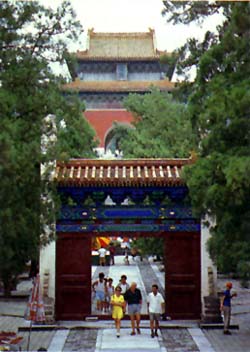|
Ming Tombs

The Ming Tombs lie in a valley to the south of the Tianshou Mountains in the Changping district, about 48km (30 miles) northwest of Beijing. 13 of the 16 Ming emperors were buried here and the tombs are "defended" from evil influences by the dragon and tiger hills on either side of the valley. Currently, only 3 of the tombs, namely Changling, Dingling and Zhaoling are open to the public.
When you enter the vicinity of the tombs, visitors first pass by an elegant, five-arched white marble memorial archway, decorated with carvings of lions, dragons and lotuses, which was built in 1540. Roughly 1km further to the northeast of this archway is the Great Red Gate (dahongmen), the outermost gate to the burial complex. This gate marks the beginning of the 7km (23 miles) long Sacred Way which leads past bridges and a river to Changling, the tomb of the third Ming emperor Yongle (1403-1424).
All the other tombs are arranged on either side of Changling and have the same structure - the building where sacrifices were prepared and offered, the stele tower where prayers were said and the tumulus that covered the underground vault. Emperor Yongle was buried in Changling with 16 royal concubines in 1424 and this tomb is considered the largest and best preserved. The first tomb to be unveiled to the public and the most extravagant tomb is Dingling, where emperor Wanli (1563-1620) and his 2 empresses were buried.
|